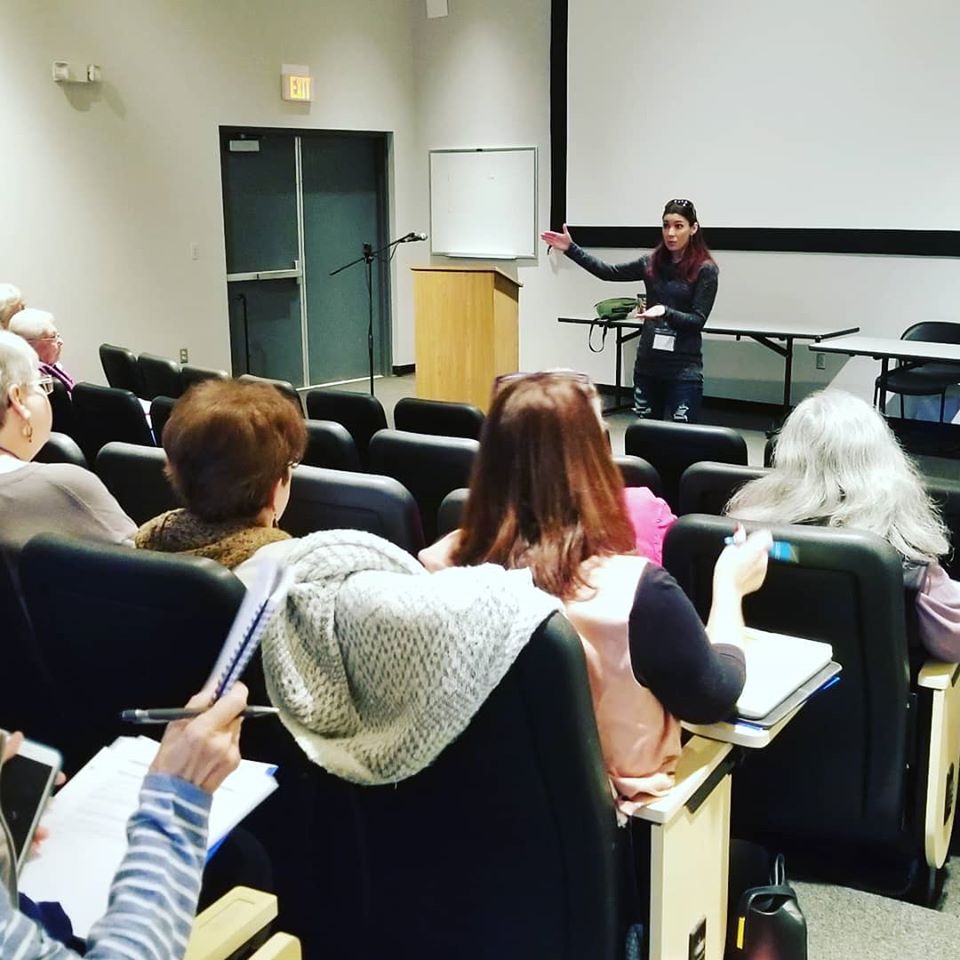Dealing With Difficult People While Leading a Nonprofit

As the leader of a Florida-based literary arts nonprofit, I’ve said on more than one occasion, “The hardest thing about working with the community is having to work with the community.”
That might sound curmudgeonly, but people can be difficult. They can be self-involved, ego-driven and entitled, and when you throw a bunch of artists into the mix, this can sometimes be amplified.
Now, I’d like to stress that 99.9% of the people we work with are lovely, talented, creative, friendly, and appreciative individuals. I’m sure this is the same for many nonprofits.
But that 0.1% can sour the work that you’re doing, especially in the nonprofit world, when you’re giving your all to build up your community. This is particularly true in the case of grassroots organizations like Wordier Than Thou, which is completely volunteer-run. Nobody is making any money. We’re doing what we do purely for the love of books, publishing, and Florida writers.
For this reason, unless we’ve made a mistake (and trust me, we’ve made missteps and always hold ourselves accountable) I tend to embrace a firm, take-no-crap stance when it comes to handling complaints and difficult people. I know I’m not going to win any customer service awards, but I’m ok with that.
Here are a few situations I’ve encountered over the years while leading a nonprofit and how I handled them. These approaches might not work for everyone, but they worked for us.
But Her Emails! Stand By Your Organization’s Values
Within the legal bounds of our nonprofit designation, we don’t raise money or campaign for political candidates. That being said, we also don’t shy away from tough topics and we don’t restrict anyone’s creative expression. We know that addressing certain issues might alienate some of our followers, but we do so because we’re privileged to have a platform that allows us to shine a light onto some of the injustices and issues in the world. Art can be many things and we firmly believe that it can be an important form of activism.
When Donald Trump announced he was running for president in 2015, he immediately stood out as a problematic candidate to us. We thought it would be a short-lived campaign, though, one that would make great fodder for satire. Around Halloween, we asked writers to imagine what his presidency might look like and organized a reading of these stories at an event called Dawn of the Donald.
Assuming he would drop out of the race, as he had in past elections, we thought that was that. When he was selected as the Republican nominee and then elected president, we organized another reading of these fictional pieces on the evening of his inauguration. We later published these stories in an anthology by the same name.

Along the way, some of our more conservative followers asked me why we didn’t host a similar event or publish a similar anthology inspired by the Democratic candidate, Hillary Clinton.
I explained to these individuals that as a racist, homophobic, misogynist, xenophobe, Trump represented a growing division in our country and we saw the potential for him to wreak havoc on our democracy if elected. (Fast forward a few years and the stories in our collection are strangely accurate.)
One individual pushed a bit further that we should also skewer Clinton with an anthology, because fair is fair and we’re a community organization that needs to appeal to all beliefs. I politely suggested they publish such a book and that was the last I heard about it.
A few of these individuals started coming to our events less frequently after that, but the relationships weren’t entirely severed, as they still come around now and again. Even if those relationships were irreparable, it would have been worth it for staying true to our values.
Sometimes You Can’t Help People If They Won’t Meet You Halfway
In February, we hosted our Tampa Bay Publishing Conference, a four-day event that focuses on the business of books. This conference features panels on various topics as well as authors sharing their personal publishing journeys.
By December, our lineup was mostly complete and looking strong. We were excited about the slate of authors joining us for our third annual conference, which has grown each year.
Enter Entitled Author.
Entitled Author, traveling from outside our region the Tampa Bay area had participated in a small way at a previous conference.
In January, they emailed me asking why I hadn’t invited them to be a featured author this year. They’ve been writing and publishing for decades, they informed me, and felt their accomplishments spoke for themselves. I didn’t know this person well, but based on previous interactions, they came across as high maintenance, so I never dreamed of inviting them to speak at our conference. Why add more stress to an already stressful weekend?
Still, I didn’t want to completely alienate them. Gritting my teeth, I messaged an apology for overlooking them, the schedule had been set for months, we’ll keep them in mind for next year based on our needs, etc.
I took it a step further and told them there was still time to submit a panel for this year’s event. I just needed a short description, title, and the names of at least three individuals who would join them on the panel.
They shot me down, saying they didn’t know any other writers they could invite to be part of a panel. I mentioned that there was room on a handful of panels I’d pulled together if they wanted to join one. They told me they most likely couldn’t get a ride to the conference, though we were more than a month out from the event.
At that point, I knew there was nothing I could offer that would make the author happy. If they didn’t try to meet me halfway, there wasn’t much I could do for them, and by being so difficult, they pretty much guaranteed that I won’t invite them to participate next year.
Know When to Go Above Their Head
Last year, Wordier Than Thou hosted an event at a nonprofit venue we often used. We pre-sold advance tickets and were also selling tickets at the door.
When I arrived, two volunteers scheduled by the venue wouldn’t let me work at the ticketing table by the front door, even though I have always worked the door at our events in this space.
They rearranged the items I set up on the table. They interrupted if I tried to answer questions from guests. They wouldn’t let me handle the cash box and created their own system for tracking ticket sales. They let people who weren’t on the guest list in for free. And I found out after the event that they didn’t accurately keep track of door sales, so I never knew the exact number of people in the audience.
Even worse, while I and other audience members were standing just a few feet from them, they loudly criticized the event and turnout. (We had about 50 people come out on a Sunday evening, not that it makes any difference.)
Their behavior was off-putting enough that the next day I emailed venue staff about it. The venue apologized, and while they couldn’t necessarily fire a volunteer, they could ensure that these two women never worked at one of our events again.
Don’t Give in to Bullies
A few years ago, we hosted a literary program through an online radio station. The station offered a good mix of local programming and syndicated shows from around the world.
The host of one of the other local shows had a reputation as being pushy, abrasive, and self-involved. They were nice enough to me at first and I usually recorded my program right after theirs, so I’d run into them often.
Then, I booked an author friend on our show. A few days later, this other host informed me they had also just booked the same author on their show and that I would need to cancel my booking. When I refused, they went off on me. I was selfish and rude and clearly should let them have the interview.
The author and I explained that the two programs would discuss different topics. Not only that, but the programs would air sporadically on the station and be available for download. There would be hardly any overlap in listeners.
This other host – despite booking this author well after me – still insisted they had the right to the interview. I never backed down, though. They complained some more to anyone who would listen and then they hit the unfriend and unfollow button on Facebook. Good riddance to bullies, I say.
Not Everyone Who Asks for a Refund Should Get One
Over the past few years, I’ve added a no-refunds policy to most events to make our lives easier.
During a recent Fiesta Day street festival in Ybor City, we organized a children’s book fair for the event. We offered booth space to authors for $50, a fair price considering this is one of the area’s largest annual events with around 10,000 people visiting the Historic District for it each year.

In the week leading up to the event, one young adult author emailed us just about every day with questions and expressing her excitement for the festival. She even contacted us the evening before with last-minute questions.
The next morning, she emailed me an hour-and-a-half before the festival started saying she woke up with a high fever and it was probably the flu. Later that day, she emailed me asking for a refund.
I politely denied her request, pointing out the last-minute nature of her cancellation and the fact that all the vendor information stated that the fee was non-refundable. Trying to be nice, I offered to let her use that $50 towards a future event, though.
She told me that “theft is a crime and a sin” and that she would never attend any of our events. That’s fine. She still isn’t getting a refund.
Our nonprofit has a small budget and we use funds from ticket sales and vendor fees to pay for the next event. If people aren’t able to attend something as they had originally planned, barring an extreme circumstance, it isn’t fair to ask for a refund, especially when all event descriptions include our no-refund policy.
That said, I know there are times to make exceptions, so we do evaluate each situation. This spring, our Harry Potter-themed drag show fundraiser was rescheduled due to the COVID-19 pandemic.
A ticketholder emailed me and said they were available for the new date in September, but they were worried about the impact the coronavirus might have on the economy and their personal funds. I didn’t hesitate to offer them a refund given the unprecedented situation caused by the pandemic.
Know When You’ve Made a Mistake and Apologize
It is important to recognize when we make mistakes. I’m always quick to apologize and to take accountability.
I’ve apologized for a lot of things lately, such as moving a virtual event to a different date when I realized the original booking didn’t work with our schedule. I had already set up the event page and began promoting it before realizing I needed to change gears. I know moving things around can be irritating to authors trying to fill their calendar and apologized profusely.
During another recent virtual event, I didn’t realize that the link to the Zoom meeting room had expired a few days earlier. I got frustrated while fielding frantic emails and Facebook messages asking how to enter the event. I apologized profusely for my mistake and worked with the author to find another date that suited them.
Ultimately, handling complaints and responding to tense interactions with creative collaborators and event guests comes down to assessing individual situations. While we believe in making amends when we make mistakes, we also don’t believe in simply giving in to difficult people. I know that not every nonprofit leader will embrace this attitude, but I’m not interested in letting jerks detract from my passion or our mission of supporting Florida’s writers and readers.
Tiffany Razzano is a journalist and copywriter living in the Tampa Bay area. For the past 8 years, she served as an editor at Tampa Bay Newspapers. She also writes regularly for La Gaceta, Watermark, The Free Press, and Creative Pinellas. She’s the founder/president/creative director of the literary arts nonprofit Wordier Than Thou, which supports Florida writers and readers through community events, publishing projects, and educational opportunities.













Recent Comments